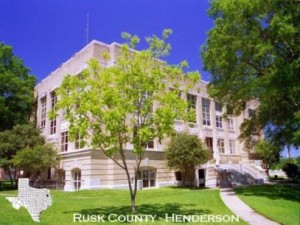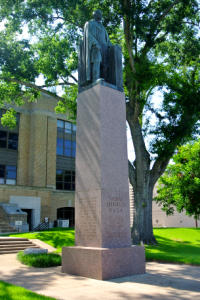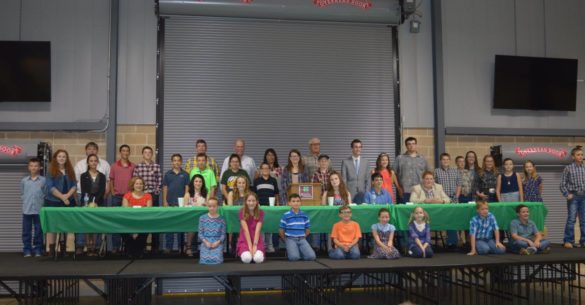 Rusk County was formed on January 16, 1843, from parts of Nacogdoches County by the Congress of the Republic of Texas. The area had been previously settled by mostly Old Southern families and included men such as James Smith (Henderson), Julien Sidney Devereux (Glenfawn, Anadarko, and Monte Verdi Plantation), and Albert Tatum (Tatum). The county was named for Thomas Jefferson Rusk, who had been the Secretary of War under President Sam Houston. The county seat was laid out near the geographical center of the county with land donations by Gen. James Smith and William B. Ochiltree, who named the town in honor of his friend, James Pinckney Henderson, who became first governor of the new State of Texas two years later.
Rusk County was formed on January 16, 1843, from parts of Nacogdoches County by the Congress of the Republic of Texas. The area had been previously settled by mostly Old Southern families and included men such as James Smith (Henderson), Julien Sidney Devereux (Glenfawn, Anadarko, and Monte Verdi Plantation), and Albert Tatum (Tatum). The county was named for Thomas Jefferson Rusk, who had been the Secretary of War under President Sam Houston. The county seat was laid out near the geographical center of the county with land donations by Gen. James Smith and William B. Ochiltree, who named the town in honor of his friend, James Pinckney Henderson, who became first governor of the new State of Texas two years later.
The area was home to early Native American communities of Cherokee, Shawnee, Caddo and Tejas tribes. Although Spanish explorers traveled through the area that would become Rusk County, they did not settle. Their only legacy here is in the names of a few streams. The first land grant was issued to William Elliott on March 22, 1829 and other early settlers were Thomas and Leonard Williams, Joseph Durst, and Henry Stockman. After the Texas Revolution, Anglo settlers arrived by way of Trammel’s Trace, the Nacogdoches Road and the Green Grass Trail.
The first U.S. Census in 1850 showed 8,148 residents in Rusk County, it was the second largest county population in the new state and included 2,136 slaves. There were 17 plantations of at least 10,000 acres. James Smith was the largest landowner with 53,000 acres. Other plantation owners listed on the census were John Graham, Richard B. Tutt, Milton M. Boggess, and William Wright Morris.
In 1860, Rusk County moved to the number one spot in population with 15,803 inhabitants (6,132 slaves) and the combined wealth of the inhabitants was $6,494,175, ranked number five in the list of counties by wealth. 1860 was hard on the residents of Rusk County with a terrible drought and record high temperatures which decimated the crops. A huge fire destroyed the courthouse and most of the business district in August. With tempers flaring over the slavery issue and the unprecedented heat adding to the mood, a new settler from the North was accused of hiring a black woman to burn the town. Green Herndon was murdered by a mob of angry citizens in Henderson in 1860. In 1861, the county voted overwhelmingly for succession. While Rusk County didn’t make much of a material contribution to the war effort, it mustered twelve companies of men to fight, the highest number of able bodied men in the state.
The results of the 1870 Federal Census showed a big change for Rusk County. The county lost revenue with the loss of the slaves, who were considered taxable property before the war. Of 21 residents with an annual income of $30,000 or more in 1860, only two remained. Both white and black farmers resorted to share‑cropping, receiving 1/3 to 1/2 of the crops they raised on land owned by other men. Rusk County escaped much of the violence visited on the citizens of other counties by Reconstruction troops through the influence of James Winwright Flanagan and his son, David Webster Flanagan, who allied themselves with the moderate Republicans.
During the 1870’s, Rusk County recovered from the drought and the war. New colleges were founded in Henderson and Kilgore and the Illinois and Great Northern Railroad reached the northwest corner of the county in 1872, allowing Overton to become a major shipping point. The rail line made it to Henderson in 1874 and the town became a leading center of commerce. That same year, Gregg County was formed from the northernmost 284 square miles of the county, capturing Kilgore and Rusk County lost several thousand residents.
In 1880, the county reported 18,986 residents but only 18,559 in 1890. The previous prosperity started to decline and by 1910, almost half of the farms were worked by share‑croppers and most were less than 75 acres.
Rusk County became prosperous once more, literally overnight, in 1930 when Columbus M “Dad” Joiner struck oil and opened up the East Texas Oilfield, one of the largest deposits in the world. Farmers began leasing their land to drillers and gave up on their crops. New towns sprang up, and the old ones thrived. Humble Oil and Refining moved 100 families from Corsicana to New London and the small town grew quickly. The small school district of Gaston consolidated with other schools in the area and quickly became the largest rural school district in the nation. Horribly, the boom proved disastrous when the New London school exploded on March 18, 1937,  due to a gas leak and killed 311 students and faculty. It was the worst school disaster in United States history.
due to a gas leak and killed 311 students and faculty. It was the worst school disaster in United States history.
Henderson is the largest town in Rusk County, reporting over 11,000 residents in the 2000 Federal Census.



